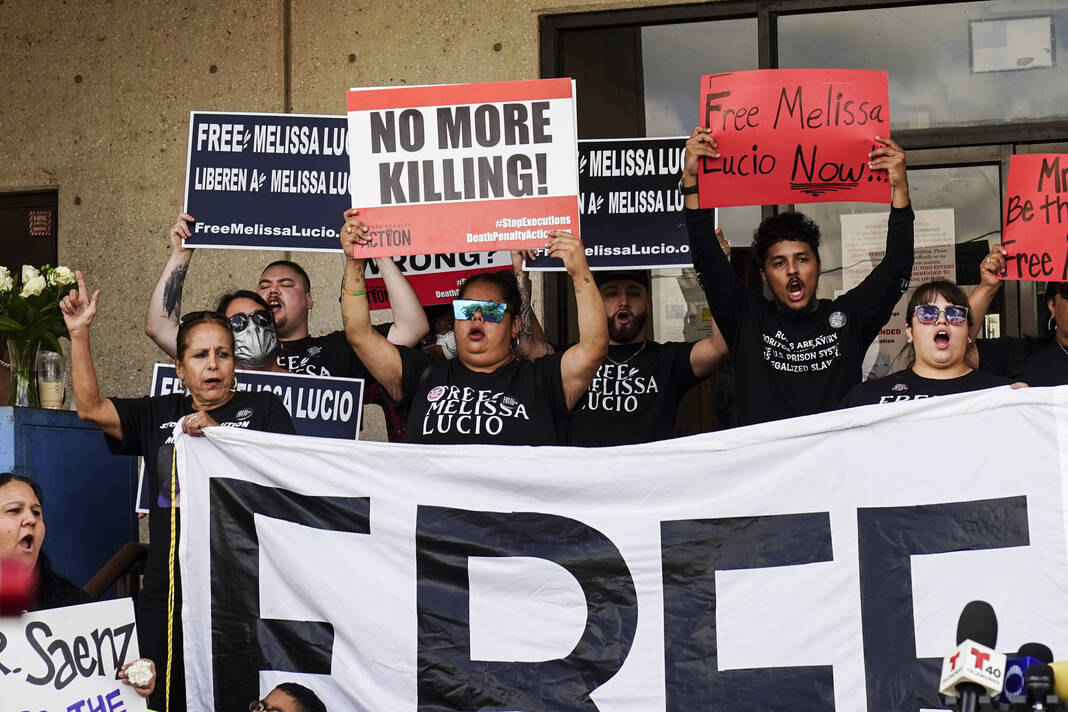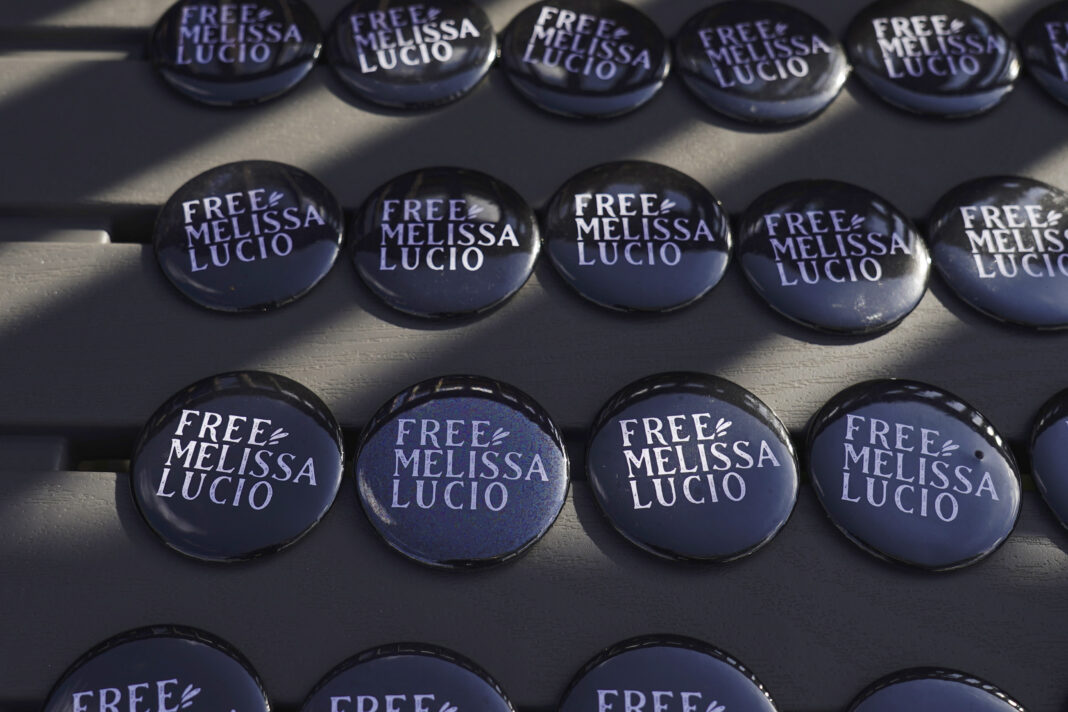
The central question to Melissa Lucio’s capital murder case is how to interpret the medical evidence.
Both prosecutors and defense attorneys agree that 2 1/2-year-old Mariah Alvarez died from head trauma in 2007, but both sides disagree about how that trauma likely occurred prior to the toddler’s death on Feb. 17, 2007.
Her autopsy photos show bruises throughout her body and what appeared to experts in her prosecution as a bite mark on her back. The prosecutors allege those injuries came from the hands of an abusive mother — and the Cameron County jury who found Lucio guilty in 2008 was told by the prosecution’s medical examiner that there was simply no other medical explanation.
However, on Monday, the Texas Court of Criminal Appeals provided the defense team its first chance to present medical evidence to argue that Mariah actually might have died as the Lucio family has always insisted — from injuries sustained from an accidental fall down a flight of stairs at their Harlingen apartment.
“She still has a death sentence,” said Vanessa Potkin, an attorney on Lucio’s defense team, updating The Brownsville Herald about the case’s current standing.
Had the Texas Board of Paroles and Pardons issued a decision on Lucio’s clemency petition Monday, her sentence might have been converted to a life sentence.
“But what happened in the Court of Criminal Appeals, by issuing a stay and remanding her case back to the trial court, her case now goes back to Brownsville — and for the first time she has an opportunity to have an evidentiary hearing where she can present evidence and witnesses that support the evidence of her innocence,” Potkin said.

In effect, rather than being granted a life sentence in place of a death sentence, Lucio’s defense team is able to stage a legal fight for her full exoneration — all while Lucio remains under the specter of a death sentence.
“There is a path to her exoneration,” Potkin said. “There’s a path to a new trial.”
Potkin is an attorney with the Innocence Project, a national organization that represents people post-conviction who have claims of factual innocence and that specializes in fighting convictions that were won through the use of false scientific or medical evidence. The Innocence Project joined the defense team in January after the now-stayed April 27 execution date was set.
“We did so because we were very concerned that an innocent woman might be executed,” Potkin said, “and when we reviewed the case we recognized that her conviction had been obtained through false scientific evidence”
Also, she added, they found there was scientific evidence of her innocence that the jury never heard.
The coming stages of the legal fight will focus heavily on the medical science behind Mariah’s head injury and other injuries. The defense maintains that the child fell down the stairs two days prior to her death as the family was moving out of an apartment and into a new home, while the state’s position is that the fatal head injury came within 24 hours of death and was the result of an intentional beating.
To preclude the possibility of an accident two days before the child died, the state’s medical examiner testified at trial that Mariah’s head injuries had to have occurred within 24 hours of her death.
“That testimony was false,” Potkin told The Brownsville Herald.

Prosecutors built an argument at the 2007 trial — and have maintained this stance through appeals — that there are no explanations for Mariah Alvarez’s injuries except for child abuse. A fall just could not explain the bruising and injuries throughout her body, the prosecution argued.
“I’ve never seen anything like this in 30 years,” Dr. Alfredo Vargas testified June 30, 2008. “This is the absolute worst (case of child abuse) I’ve ever seen.”
Yet, the family’s history with Child Protective Services indicated drug use by Lucio and neglect, rather than abuse, at the Lucio home. According to an article in the Feb. 23, 2007 edition of the Valley Morning Star, Regina Garcia, a Corpus Christ-area spokeswoman for the Texas Department of Family and Protective Service, which oversees CPS, said the family’s children were removed from the home in 2004 on allegations of neglect.
Mariah was returned to Lucio’s care in November 2006, and CPS remained in contact with the home.
“CPS still remained overseeing their care,” Garcia was quoted then. “There were random visits and random drug testing. It all appeared fine.”
Convinced of abuse, prosecutors left the jury to consider these words in closing arguments at the 2008 trial: “This wasn’t an isolated incident where she lost it and she killed this child. She made this child suffer. Every time she injured this child she had to have gotten some pleasure from it because she didn’t do it one time. She did it over a period of weeks and probably months.”

However, Dr. Michael Laposata, chairman of the Department of Pathology at the University of Texas Medical Branch-Galveston, has offered the case an alternative explanation.
“Disseminated intravascular coagulation (DIC) is an acquitted coagulation disorder characterized by excessive activation of coagulation, resulting in both hemorrhage (bleeding) and abnormal thrombosis (clotting),” Laposata stated in a declaration for the defense motion to the Texas Court of Criminal Appeals. “Some common causes of DIC include infection, trauma, and shock.”
Laposata stated DIC has developed as a result of accidental injuries, including motor vehicle accidents and falls.
“Trauma to the head is a notorious catalyst for DIC/clotting reactions,” he said. “This is because when tissue factor is exposed to blood, clotting results. Tissue factor is in high concentration in the brain and clotting can quickly spread throughout the body when the brain is injured.”
According to Laposata, this disorder can cause “significant and widespread bleeding throughout the body” and “profound bruising throughout their body.” Such bruising can develop within minutes after traumatic injury — or days later, he said.
Routine handling of the patient at home or in a hospital setting can cause significant bruising, he stated.
“It is not possible to tell the difference between a bruise from DIC and a bruise from abuse,” he said.
With expertise that includes coagulation disorders, Laposata was identified by a November 2015 peer-nominated survey in The Pathologist, a journal reporting on the practice of pathology, as the most-influential pathologist in the United States —and the third most-influential in the world.
Lucio’s defense attorneys asked Laposata about clots documents in Mariah Alvarez’s autopsy, which he said was consistent with DIC. The doctor was also asked to review the trial testimony of the medical examiner, Dr. Norma Jean Farley, who took the witness stand for the prosecution in 2008.
“Dr. Farley testified that the absence of hemosiderin deposits and the absence of microphages indicate that the injuries to the brain were sustained within approximately 24 hours of autopsy,” Laposata stated. “Dr. Farley testified that had these injuries been sustained two days prior to autopsy, hemosiderin and microphages would certainly have been present.
“This testimony was incorrect,” Laposata said, explaining that hemosiderin and microphages can take longer than two days to develop after an injury — even being “first visible up to four days post-injury,” or even longer in some cases.
Farley’s testimony was damaging to Lucio’s defense in 2008, Potkin said.
The reason, Potkin explained, “that (testimony) was so significant was because if you have that medical testimony saying the injury had to have happened within 24 hours, then it couldn’t have happened as Melissa said. But that testimony was false.”
When Mariah Alvarez’s autopsy photos were shown to jurors on July 3, 2008, Farley testified those injuries could not have been caused by a fall down stairs. “It is my opinion that they came from a beating,” Farley testified, according to the Valley Morning Star.
The medical examiner agreed with defense cross-examination that fatal blunt force head trauma such as Mariah Alvarez had suffered could be caused from an accident “but the child looked beaten around the head, not from falling down the stairs.”
Potkin argues such testimony was pivotal in convicting her client.
She told The Brownsville Herald: “Because if you are presented with photographs of Mariah’s body that’s profoundly bruised and you have an expert saying that the only possible cause of the bruising is a beating, then what other verdict is going to be reached other than guilty? What other conclusion is going to be reached other than this is a murder? But, in fact, all of Mariah’s injuries were consistent with complications from her accident.”
Also consistent with DIC, Potkin said, is evidence that Mariah’s body temperature remained elevated, signaling possible infection.
“They took her body temperature,” Potkin said. “And even a significant time after her death, she still had an elevated body temperature, and usually the body starts to cool. That was an indication of infection.”
At the conclusion of Laposata’s declaration to the appeals court, he said he was “providing this declaration because child abuse is a diagnosis of exclusion. Medical guidance, including from the American Academy of Pediatrics, is clear that before determining whether injuries were caused by child abuse, physicians must rule out coagulopathiess such as DIC.”
Although bruises could be explained by DIC, according to Laposata, the autopsy also revealed what prosecutors allege is a bite mark on the baby’s back.

Bitemark evidence was accepted as a forensic technique for decades, at least until recently, said Dr. Adam J. Freeman, a past president of the American Society of Forensic Odontology, who provided a declaration to the appeals court that scientific studies “universally point to major issues” with the reliability and validity of bitemark evidence.
According to Freeman, the National Academy of Sciences in 2009, a year after Lucio’s trial, published a review of the scientific bases of forensic disciplines, such as bitemark evidence, and found “that bitemark evidence is scientifically invalid, grossly subjective, and especially prone to the influence of cognitive bias.”
Bitemarks are a patterned injury. It appears one of the problems with bitemark evidence is that experts cannot reliably identify bitemarks from among other patterned injuries, according to Freeman’s declaration.
“I have seen numerous examples for circular or half-mooned injuries — not dissimilar to the wounds here at issue here — that both laypeople and forensic odontologists have mischaracterized as human bitemarks, when the wounds were actually caused by a range of inanimate objects, even a child’s toy or a piece of fencing,” Freeman stated. “In fact, contact with any circular, hard object to the human body can cause a wound that may appear consistent with a bitemark.”
Freeman disagrees with testimony given at trial over the marks on Mariah Alvarez’s back, calling the testimony unscientific, unreliable, highly inflammatory “prejudicial speculation, and would likewise be inadmissible at trial today.”
In recent weeks, the district attorney has declined all requests for media interviews related to the case.
On Monday, Saenz released a statement that read: “As I stated before, I welcome the opportunity to prosecute this case in the courtroom: where witnesses testify under oath, where witnesses may be cross-examined, where evidence is governed by the rules of evidence and criminal procedure, and where the court rules pursuant to the rule of law. That is our criminal jurisprudence system, and it is working.”
The district attorney will likely press other injuries revealed by the autopsy, such as a spiral fracture on one of Mariah’s arms that had healed on its own without medical treatment.
“One of her arms had been broken probably about two to seven weeks before her death, and she was missing portions of her hair where it had been pulled out by the roots,” stated a response from the district attorney’s office to Lucio’s motion to the Texas Court of Criminal Appeals.
The district attorney’s response also detailed allegations centered on drugs.
“The police found paraphernalia for smoking crack cocaine in a search of (Lucio’s) apartment after Mariah’s death,” the document stated. “Farley testified that Mariah had cocaine in her blood at the time of her death. Other evidence was presented that (Lucio) received about $5,000 per month in welfare benefits most of which the State claimed (she) used to support a cocaine habit.”
According to Valley Morning Star archives, the trial defense attorney in 2008 countered that neither Lucio nor her husband were tested for drugs in the investigation — nor were any laboratory tests ordered to identify drug residue on paraphernalia found at the home.
Lucio was the first woman to be convicted of capital murder in Cameron County. She was sentenced to death — but she had also faced a sentence as light as 5 to 99 years in prison.
To date, Lucio has been imprisoned for more than 13 years.
If ultimately put to death, she would be the first Latina executed by Texas and the first woman the state has put to death since 2014.





